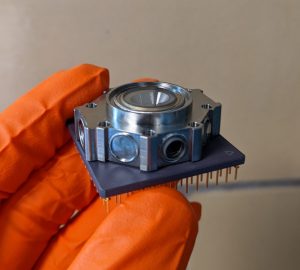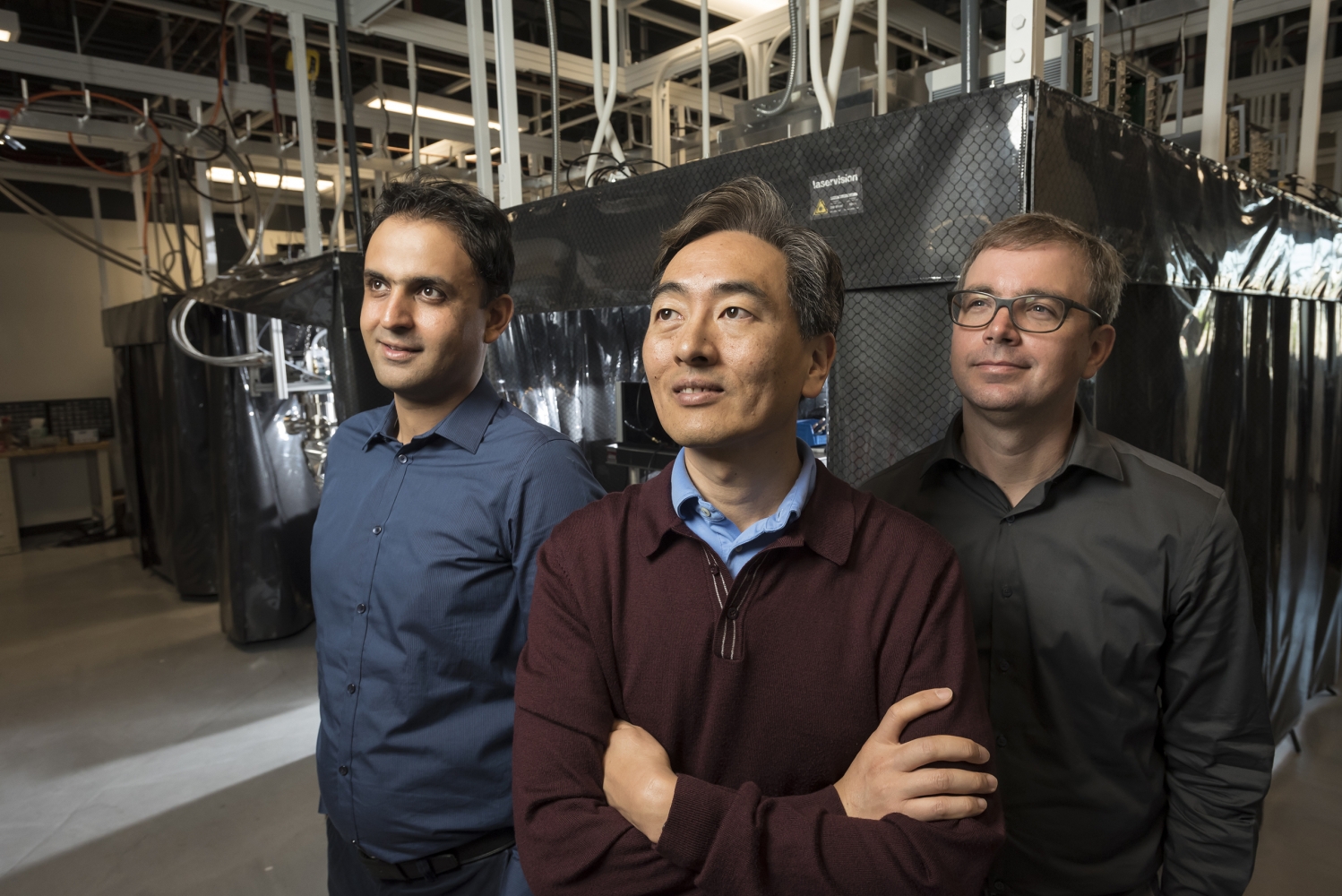 The heart of our quantum computers is a collection of individual atoms as the quantum bits or qubits. These atomic ions are all the same isotope and element to form an atomically perfect crystal. They are levitated in free space by electrodes on a nearby chip device carrying radiofrequency and static electrical potentials, all in a vacuum environment.
The heart of our quantum computers is a collection of individual atoms as the quantum bits or qubits. These atomic ions are all the same isotope and element to form an atomically perfect crystal. They are levitated in free space by electrodes on a nearby chip device carrying radiofrequency and static electrical potentials, all in a vacuum environment.
We integrate these chip traps in specially designed room-temperature or cryogenic (4K) vacuum chambers. Importantly, the confinement of the atomic qubits has absolutely no effect on the qubit itself, which is a unique feature of trapped ions. Finally, we surround the system with reconfigurable optical controllers, where laser beams poke the atomic qubits and allow qubit initialization, universal quantum logic gates and qubit measurement, forming for the most powerful research quantum computers available today.

At the component level, our qubits can be perfectly replicated and are nearly perfectly isolated from the environment, because they are atomic clocks. These pristine attributes allow the indefinite scaling of trapped ion quantum computers. At the system level, we are continually modifying and updating our quantum computers, and as we scale to more qubits, the systems are getting smaller and more reliable, in an example of quantum systems engineering. This approach will allow us to deploy ever more powerful systems for scientific applications of all kinds.
Recent News

‘More Possibilities Than There Are Particles in the Universe’
Jungsang Kim was a bit of an anomaly at Duke when he joined the faculty in 2004. Fresh out of the telecommunications industry, and with a PhD in physics from Stanford, Kim soon filled his new Duke lab in electrical and computer engineering with delicate, complex constructions marrying physics and engineering: reconfigurable optical systems whose… Read More »‘More Possibilities Than There Are Particles in the Universe’

Chris Monroe: Realizing Ion-Trap Quantum Computers to Solve Unsolvable Problems
An international leader in quantum computing, architect of the U.S. National Quantum Initiative, and member of the National Academy of Sciences, Chris Monroe will join longtime long-distance collaborators at Duke to build practical quantum computers for use in fields from finance to pharmaceuticals. Chris Monroe, one of the world’s leading experts in trapping atoms and… Read More »Chris Monroe: Realizing Ion-Trap Quantum Computers to Solve Unsolvable Problems

Duke Joins Peers on New National Quantum Initiative Advisory Committee
Duke University researchers Jungsang Kim and Christopher Monroe will join peers from the national labs, universities, federal agencies and industry on a new National Quantum Initiative Advisory Committee (NQIAC) recently announced by the U.S. Department of Energy and the White House Office of Science and Technology Policy (OSTP). The NQIAC’s mission is to “counsel the… Read More »Duke Joins Peers on New National Quantum Initiative Advisory Committee

Marko Cetina: Building Quantum Machines to Understand Physical Processes
In July 2021, Marko Cetina will join Duke University’s Department of Physics as an Assistant Professor. An atomic, molecular and optical physicist, Cetina has used his wide-ranging research in light, lasers and atoms to both explore the basic physics of quantum phenomena and support the development of improved technology necessary for today’s leading quantum machines.… Read More »Marko Cetina: Building Quantum Machines to Understand Physical Processes

Quantum Systems Accelerator (QSA)
Duke University is joining 14 U.S. institutions in a five-year, $115 million effort to forge the technological solutions needed to harness quantum information science for discoveries that benefit the world. Funded by the Department of Energy, the Quantum Systems Accelerator (QSA) will be led by Lawrence Berkeley National Laboratory (Berkeley Lab) and energize the nation’s… Read More »Quantum Systems Accelerator (QSA)

Software Tailored Architectures for Quantum CoDesign (STAQ)
Researchers from Duke University will lead a seven-university, $15 million collaboration with the audacious goal of building the world’s first practical quantum computer. Dubbed the Software-Tailored Architecture for Quantum co-design (STAQ) project, the effort seeks to demonstrate a quantum advantage over traditional computers within five years using ion trap technology. The project is the result… Read More »Software Tailored Architectures for Quantum CoDesign (STAQ)

Extensible Universal Reconfigurable Ion trap Quantum Archtype (EURIQA)
A team of researchers led by Duke University and the University of Maryland have been tapped by the nation’s own “Q Branch” to take quantum computing efforts to the next level using one of the field’s leading technologies—ion traps. The Intelligence Advanced Research Projects Activity (IARPA) invests in high-risk, high-payoff research programs to tackle some… Read More »Extensible Universal Reconfigurable Ion trap Quantum Archtype (EURIQA)